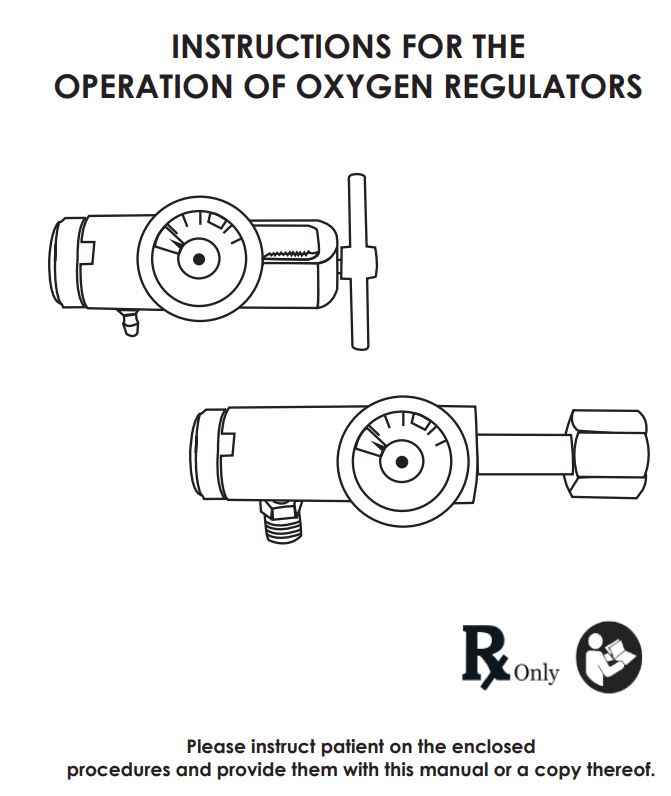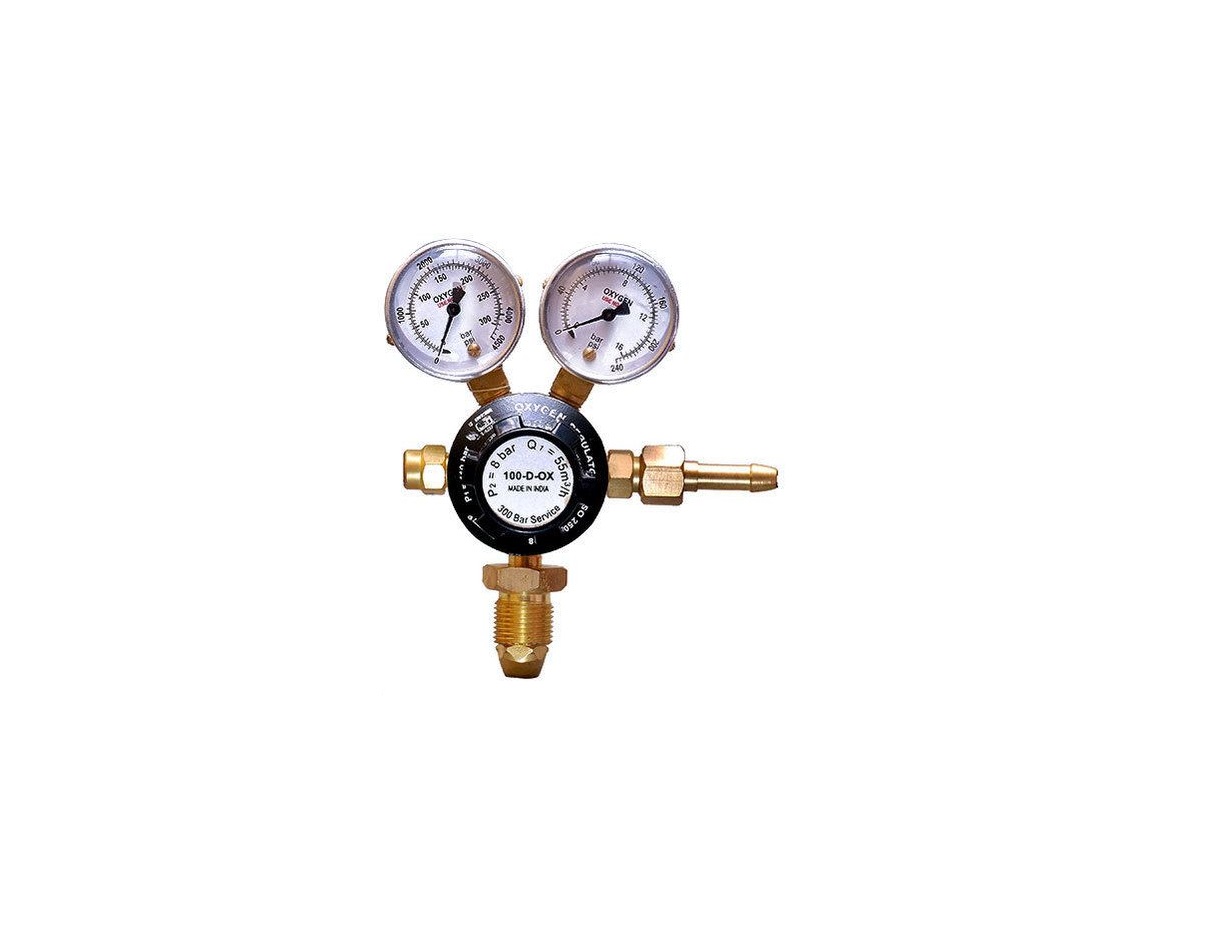R only Oxygen Regulators Instructions

INTENDED USE![]() This device is for medical use only and requires the prescription of a healthcare professional. The intended use of this device is to regulate the flow of oxygen from a high pressure oxygen cylinder. This device is to be used by or after instruction from a trained professional.
This device is for medical use only and requires the prescription of a healthcare professional. The intended use of this device is to regulate the flow of oxygen from a high pressure oxygen cylinder. This device is to be used by or after instruction from a trained professional.
RECEIVING / INSPECTIONPrior to use, remove the oxygen regulator from the packaging and inspect for damage. If damage is suspected, DO NOT USE and contact your Provider.
READ INSTRUCTIONS PRIOR TO USE![]() This device should be installed only by a healthcare professional. If you do not understand this manual, DO NOT USE the regulator and contact your Provider.
This device should be installed only by a healthcare professional. If you do not understand this manual, DO NOT USE the regulator and contact your Provider.
WARNINGS & CAUTIONS
![]() CAUTION: Indicates a potentially hazardous situation that may result in damage to property or injury.
CAUTION: Indicates a potentially hazardous situation that may result in damage to property or injury.![]() WARNING: Indicates a potentially hazardous situation that may result in property damage, serious injury or death.In the event of a medical emergency dial 911 for immediate assistance.
WARNING: Indicates a potentially hazardous situation that may result in property damage, serious injury or death.In the event of a medical emergency dial 911 for immediate assistance.
![]()
![]()
![]()
![]()
![]()
![]()
- Only personnel instructed and trained in its use should operate the regulator.
- Follow ANSI and CGA standards for Medical Gas Products and Flowmeters and Oxygen Handling.
- Prior to handling regulator and cylinder valve, be sure hands are free of oil, grease and other contaminants.
- DO NOT use if oil, grease or contaminants are present on or around the regulator, cylinder valve or connecting devices. Particulates propelled in a high velocity oxygen stream may create a spark, causing a fire. Oil and grease can react with oxygen and other oxidizers, causing an explosion
- DO NOT use tape, oils, greases, petroleum jellies, organic lubricants, paint or any other hydrocarbon based or combustible materials on or near this oxygen regulator
- DO NOT use near any type of flame or flammable/explosive substances, vapors or atmosphere.
- DO NOT smoke in an area where oxygen is being administered.
![]()
![]()
- This regulator contains magnetic, ferrous material that may affect the results of an MRI.
- Ensure all connections are tight and leak free.
- Only use oxygen safe leak detection solutions to test for leaks.
- This oxygen regulator is not intended to be used with an oxygen conserving device.
- DO NOT direct the flow of oxygen at any person or flammable material when purging the cylinder.
- DO NOT attempt to repair regulator.
LIMITED WARRANTY AND LIMITATION OF LIABILITYResponsive Respiratory warrants that the oxygen regulator will be free of defects in workmanship and/or materials for a period of one (1) year from date of shipment.
For warranty or repair inquiries, please contact your Provider for information. Responsive Respiratory does not accept returns directly from end-users. Abuse, neglect, accident or repair by other than Responsive Respiratory immediately voids the product warranty. Warranty does not extend to parts (barb, DISS, handle, washer, flow knob) and accessories.
Should any failure to conform to this warranty appear within the applicable period, Responsive Respiratory shall, upon written notification thereof and substantiation that the regulator has been stored, installed, maintained and operated in accordance with Responsive Respirator’s instructions and standard industry practice, and that no modifications, substitutions or alterations have been made to the regulator, correct such defect by suitable repair or replacement at its own expense. Return shipping costs are the responsibility of the Purchaser.
ORAL STATEMENTS DO NOT CONSTITUTE WARRANTIES
The Provider is not authorized to make oral warranties about the regulator described in this contract, and any such statements shall not be relied upon and are not part of the contract for sale. Thus, this writing is a final, complete and exclusive statement of the terms of that contract.
THIS WARRANTY IS EXCLUSIVE AND IS IN LIEU OF ANY WARRANTY OF MERCHANTABILITY, FITNESS FOR A PARTICULAR PURPOSE OR OTHER WARRANTY OF QUALITY, WHETHER EXPRESS OR IMPLIED.
Responsive Respiratory shall not under any circumstances be liable for special, incidental or consequential damages including but not limited to lost profits, lost sales, or injury to person or property arising from use of or improper training for the use or maintenance of the device. Correction of non-conformities as provided above shall constitute fulfillment of all liabilities of Responsive Respiratory whether based on contract, negligence, strict or otherwise. Responsive Respiratory reserves the right to discontinue manufacture of any product or change product materials, designs or specifications without notice.Responsive Respiratory reserves the right to correct clerical or typographical errors without penalty.
PRIOR TO INSTALLING THE REGULATOR
- Inspect the cylinder valve following the instructions of your gas supplier. A damaged valve may leak or fail to make a tight connection with the regulator. Prior to installing the regulator, open the cylinder valve slightly to purge the valve seat of any foreign particles.NOTE: Point cylinder valve AWAY from your body before opening. Close valve again.
- Inspect the regulator for oil, grease and other contaminants. If these are visible, DO NOT use the regulator.
- Ensure the regulator is in the zero (0) “OFF” position.
- Inspect the seal washer (CGA 870 connection only) for damage and contamination. If either is visible, replace immediately with a new seal washer (#200-0120 Viton or #200-0122 Bungan seal washers are recommended).NOTE: Use only one seal washer at a time. DO NOT use plastic/ nylon yoke seals.


REGULATOR INSTALLATION AND USE
![]()
![]()
![]()
CGA 870 connection (Yoke):1a. Ensure the sealing washer is in place on the regulator inlet.NOTE: Use only 1 sealing washer at a time.2a. Loosen T-Handle. Slip the yoke over the cylinder post and fit the two guide pins into the holes on the cylinder valve.3a. Turn the T-Handle clockwise until the screw point is seated into the dimple on the cylinder valve. Ensure the regulator is tightened securely onto the cylinder. Hand tighten only. Proceed to Step 4.![]()
![]()
![]()
4. Attach oxygen supply tubing to the outlet connection(s).5. SLOWLY turn the cylinder valve on (counter-clockwise) one full turn until completely open. Turn flow setting knob clockwise until the prescribed setting shows in the window. Use as instructed.NOTE: The flow selector knob must be set at a marked flow setting. Placing the knob between settings may result in inaccurate flow or no flow at all.
![]()
![]()
![]()
![]()
![]()
![]()
TURNING OFF REGULATOR
When device is not in use, turn the regulator to the zero (0) “OFF” position. Close the cylinder valve (clockwise) until completely closed and then turn the regulator back on to relieve the built up pressure until the gauge reads zero (0). Turn the regulator to the zero (0) “OFF” position.
![]()
![]()
REGULATOR REMOVAL
- Turn the regulator to the zero (0) “OFF” position.
- Turn the cylinder valve off (clockwise) until completely closed. Turn the regulator back on to release the built up pressure and the gauge reads zero (0). Turn the regulator to zero (0) “OFF” position.
- Loosen the T-Handle or nut. Remove regulator.
![]()
![]()
![]()
![]()
![]()
![]()
TROUBLESHOOTING
No Oxygen is Flowing:
- Cylinder valve may be closed. Turn on cylinder.
- Regulator is in zero (0) “OFF” position or between flow settings. Turn flow knob to prescribed flow setting.
- Cylinder may be empty if the regulator gauge reads zero. Follow regulator removal procedure and replace tank.
A Hissing Sound is Heard:
- A leak may be present. Turn the regulator off to the zero (0) “OFF” position. Turn the cylinder off, then turn the regulator to the “ON” position to relieve built up pressure until the gauge reads zero (0). Remove the regulator and then reaffix to the cylinder. Slowly open cylinder again. If hissing persists, shut the system down again and contact your healthcare Provider. NEVER attempt to repair a regulator or cylinder yourself.
- The seal washer may be faulty (Yoke style only). Follow regulator removal procedure and replace with a new seal washer (#200-0120 seal washer is recommended). DO NOT use plastic/nylon yoke seals. Use only one (1) seal washer at a time.
MAINTENANCE, CLEANING & STORAGE
- Prior to cleaning, remove regulator from cylinder and disconnect all cannula, tubing and connectors.
- Surface clean exterior of the regulator with a damp cloth and wipe dry.
- Visually inspect seal washer. If it is visibly worn or has come into contact with any cleaning solution, it MUST be replaced. Follow regulator removal procedure and replace with a new seal washer (#200-0120 Viton or #200-0122 Bunyan seal washers are recommended). DO NOT use plastic/nylon yoke seals. Use only one (1) seal washer at a time.
- Store in a resealable zip top plastic bag away from oils, grease and other contaminants.
![]()
![]()
![]()
![]()
![]()
![]()
![]()
![]()
- DO NOT use cleaning solutions with oxygen equipment.
- DO NOT immerse the regulator in any kind of liquid.
- DO NOT autoclave.
- DO NOT gas sterilize with ETO (Ethylene Oxide).
- DO NOT clean with aromatic hydrocarbons.
[xyz-ips snippet=”download-snippet”]

